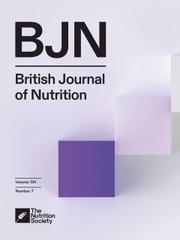Article contents
Studies on the roles of apotransferrin and caeruloplasmin (EC 1.16.3.1) on iron absorption in copper-deficient rats using an isolated vascularly- and luminally-perfused intestinal preparation
Published online by Cambridge University Press: 09 March 2007
Abstract
1. Studies have been made on the effects of dietary copper on the iron and Cu distribution in rats and on the metabolic activity and absorptive capacity of intestines perfused both vascularly and luminally.
2. Rats maintained for 4–5 weeks on a Cu-deficient diet (0.4μg Cu/kg) had significantly lower plasma, liver and intestinal Cu concentrations and significantly reduced plasma caeruloplasmin and liver cytochrome c oxidase (EC 1.9.3.1) activity compared with controls receiving a Cu-supplemented diet (5 μg Cu/kg). Disturbances in Fe metabolism in Cu-deficient rats were evident as shown by a mild anaemia, significantly elevated hepatic Fe concentrations and hypoferraemia.
3. Intestinal glucose uptake from both the luminal perfusion medium (LPM) and vascular perfusion medium (VPM) was unaffected by Cu deficiency despite a significant (25–30 %) reduction in oxygen consumption. This was associated with a 40% decline in mucosal cytochrome c oxidase activity.
4. In studies of Fe absorption, Fe uptake from the LPM was unaffected by Cu deficiency while transfer of Fe to VPM was significantly reduced (50%) compared with control preparations. Addition of apotransferrin (1 g/l) to the VPM was without effect in preparations from control rats but significantly increased the transfer of Fe to the VPM in preparations from Cu-deficient rats without affecting Fe uptake from the LPM.
5. The addition of either human or porcine caeruloplasmin (together with apotransferrin) to the VPM, such that the resultant ferroxidase (EC 1.16.3.1) activity of the VPM supernatant fraction was four to five times that of normal rat plasma, was without effect on either Fe uptake, tissue retention or Fe transfer to the VPM by preparations from either Cu-deficient or control rats.
6. These findings offer no evidence in support of the proposed role for caeruloplasmin with its associated ferroxidase activity in Fe absorption in the rat.
Information
- Type
- General Nutrition papers
- Information
- Copyright
- Copyright © The Nutrition Society 1988
References
- 22
- Cited by

